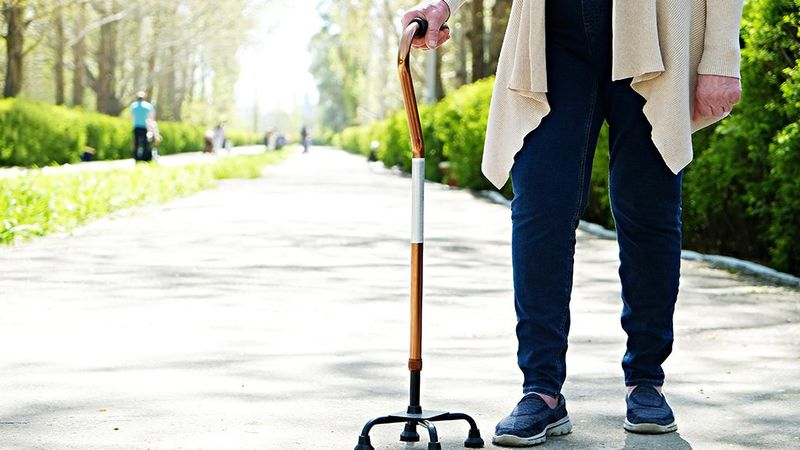




Selecting an assistive walking device is a highly personal choice. If you're looking for one that promotes stability and balance, consider choosing a quad cane.
Quad canes have a low center of gravity with four points of contact with the ground, whereas traditional canes only have one. As a result, quad canes are stable enough to stand on their own. Quad canes are designed for a range of heights and may have additional features like comfortable grips, foldable designs, or wrist straps.
Considerations when choosing quad canes
True quad vs. quad-pod canes
True quad canes feature four well-defined feet spaced out over a few inches. They excel when it comes to overall stability. Unfortunately, their durable design means they can be heavy, and their shape makes them cumbersome to climb stairs.
Quad-pods are compact versions of true pods and have a molded four-way "webbing" instead of separate feet. These are lightweight and ideal for quick movement. While quad-pods are streamlined, they can be somewhat less stable than true quads.
Right vs. left hand
Yes, there are such things are right- or left-handed quad cane styles, and you'll need the correct style for safety and comfort reasons. There are also quad canes with adjustiblity features, in which you're able to reposition the handle to accommodate your hand.
Height considerations
Quad canes aren't one-size-fits-all -- you'll need one that fits your height. Your best bet is to find one that allows for a 15-degree elbow bend. Some canes are sold in standard lengths, whereas others can be adjusted to accommodate individuals between 5 feet and 6 feet 5 inches tall.
Weight limit
Since you're putting your body weight on a quad cane, it's important to buy one with a weight limit that works for you. Most quad canes will accommodate users weighing up to 250 to 300 pounds. If you require a more advanced quad cane, you can explore bariatric models instead.
Grip
An ergonomic grip is a top feature to compare in quad canes. Some are specially designed for users with hand or wrist problems, and there are even some made to accommodate those with smaller hands.
Features
Quad canes often come with features to improve comfort, portability, and navigation.
It's no secret that quad canes can be bulky, so some people gravitate toward folding models. These collapsible models can be packed into handbags and carry-on luggage with ease.
If you're concerned about dropping or losing your grip on a quad cane, consider one with a wrist strap. Simply slide your hand through the loop for added security.
Certain quad canes are equipped with lights, making them a solid choice if you need to get up in the middle of the night or navigate poorly lit places. Lights can be removable or integrated, or you can even opt to attach your own lights to a quad cane.
Price
Basic quad-pods with limited features cost less than $25, while styles between $25 to $30 include true quads and quad-pods, many of which have larger weight capacities. Quad canes for $30 and above are often specially designed with ergonomic grips, LED lights, or pivot features.
FAQ
Q. I'm concerned someone might mistake my quad cane for theirs and take it by accident. What can I do to prevent that?
A. Some quad canes are available in a variety of colors, and you can choose one that is unique and easy to identify. Other users opt to decorate their cane with electrical or duct tape. It's also a good idea to include your contact information on your quad cane.
Q. Will quad canes damage hardwood or marble floors?
A. Quad canes are equipped with rubber covers to protect floors. In addition to being non-scratch, these covers also improve traction on smooth surfaces like hardwood, marble, tile, or linoleum.
Source:Chicagotribune

Selecting an assistive walking device is a highly personal choice. If you're looking for one that promotes stability and balance, consider choosing a quad cane.
Quad canes have a low center of gravity with four points of contact with the ground, whereas traditional canes only have one. As a result, quad canes are stable enough to stand on their own. Quad canes are designed for a range of heights and may have additional features like comfortable grips, foldable designs, or wrist straps.
Considerations when choosing quad canes
True quad vs. quad-pod canes
True quad canes feature four well-defined feet spaced out over a few inches. They excel when it comes to overall stability. Unfortunately, their durable design means they can be heavy, and their shape makes them cumbersome to climb stairs.
Quad-pods are compact versions of true pods and have a molded four-way "webbing" instead of separate feet. These are lightweight and ideal for quick movement. While quad-pods are streamlined, they can be somewhat less stable than true quads.
Right vs. left hand
Yes, there are such things are right- or left-handed quad cane styles, and you'll need the correct style for safety and comfort reasons. There are also quad canes with adjustiblity features, in which you're able to reposition the handle to accommodate your hand.
Height considerations
Quad canes aren't one-size-fits-all -- you'll need one that fits your height. Your best bet is to find one that allows for a 15-degree elbow bend. Some canes are sold in standard lengths, whereas others can be adjusted to accommodate individuals between 5 feet and 6 feet 5 inches tall.
Weight limit
Since you're putting your body weight on a quad cane, it's important to buy one with a weight limit that works for you. Most quad canes will accommodate users weighing up to 250 to 300 pounds. If you require a more advanced quad cane, you can explore bariatric models instead.
Grip
An ergonomic grip is a top feature to compare in quad canes. Some are specially designed for users with hand or wrist problems, and there are even some made to accommodate those with smaller hands.
Features
Quad canes often come with features to improve comfort, portability, and navigation.
It's no secret that quad canes can be bulky, so some people gravitate toward folding models. These collapsible models can be packed into handbags and carry-on luggage with ease.
If you're concerned about dropping or losing your grip on a quad cane, consider one with a wrist strap. Simply slide your hand through the loop for added security.
Certain quad canes are equipped with lights, making them a solid choice if you need to get up in the middle of the night or navigate poorly lit places. Lights can be removable or integrated, or you can even opt to attach your own lights to a quad cane.
Price
Basic quad-pods with limited features cost less than $25, while styles between $25 to $30 include true quads and quad-pods, many of which have larger weight capacities. Quad canes for $30 and above are often specially designed with ergonomic grips, LED lights, or pivot features.
FAQ
Q. I'm concerned someone might mistake my quad cane for theirs and take it by accident. What can I do to prevent that?
A. Some quad canes are available in a variety of colors, and you can choose one that is unique and easy to identify. Other users opt to decorate their cane with electrical or duct tape. It's also a good idea to include your contact information on your quad cane.
Q. Will quad canes damage hardwood or marble floors?
A. Quad canes are equipped with rubber covers to protect floors. In addition to being non-scratch, these covers also improve traction on smooth surfaces like hardwood, marble, tile, or linoleum.
Source:Chicagotribune